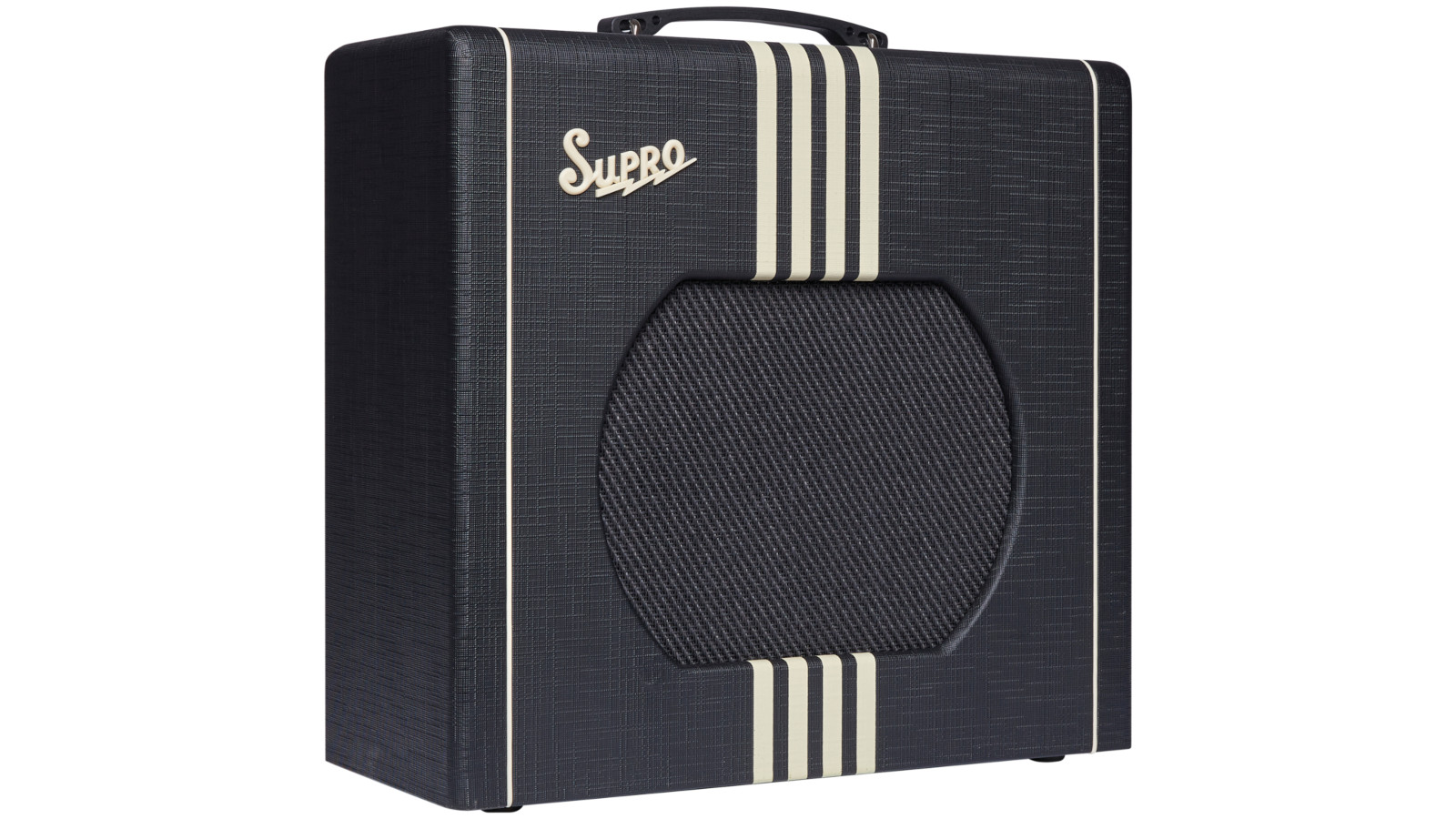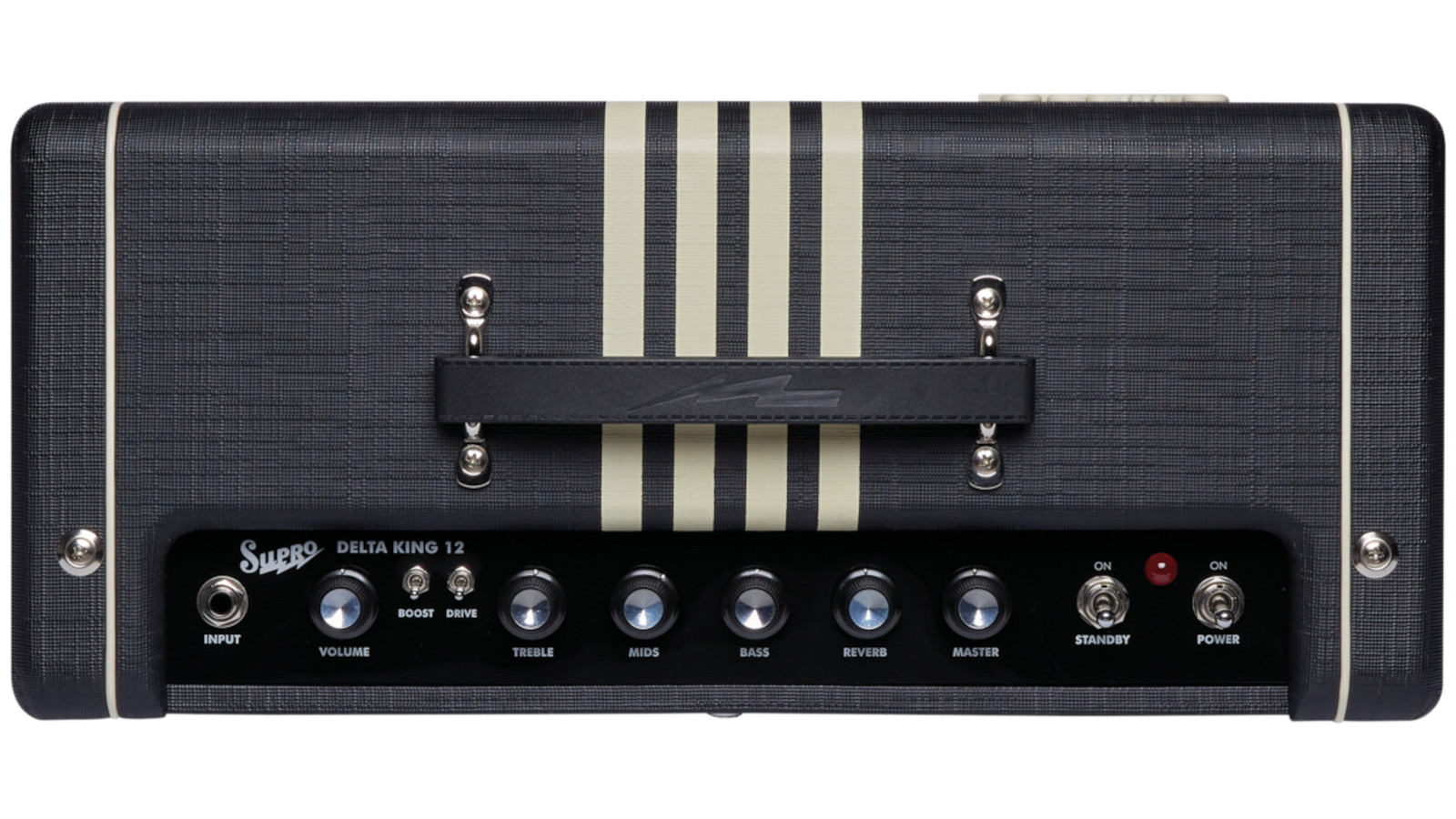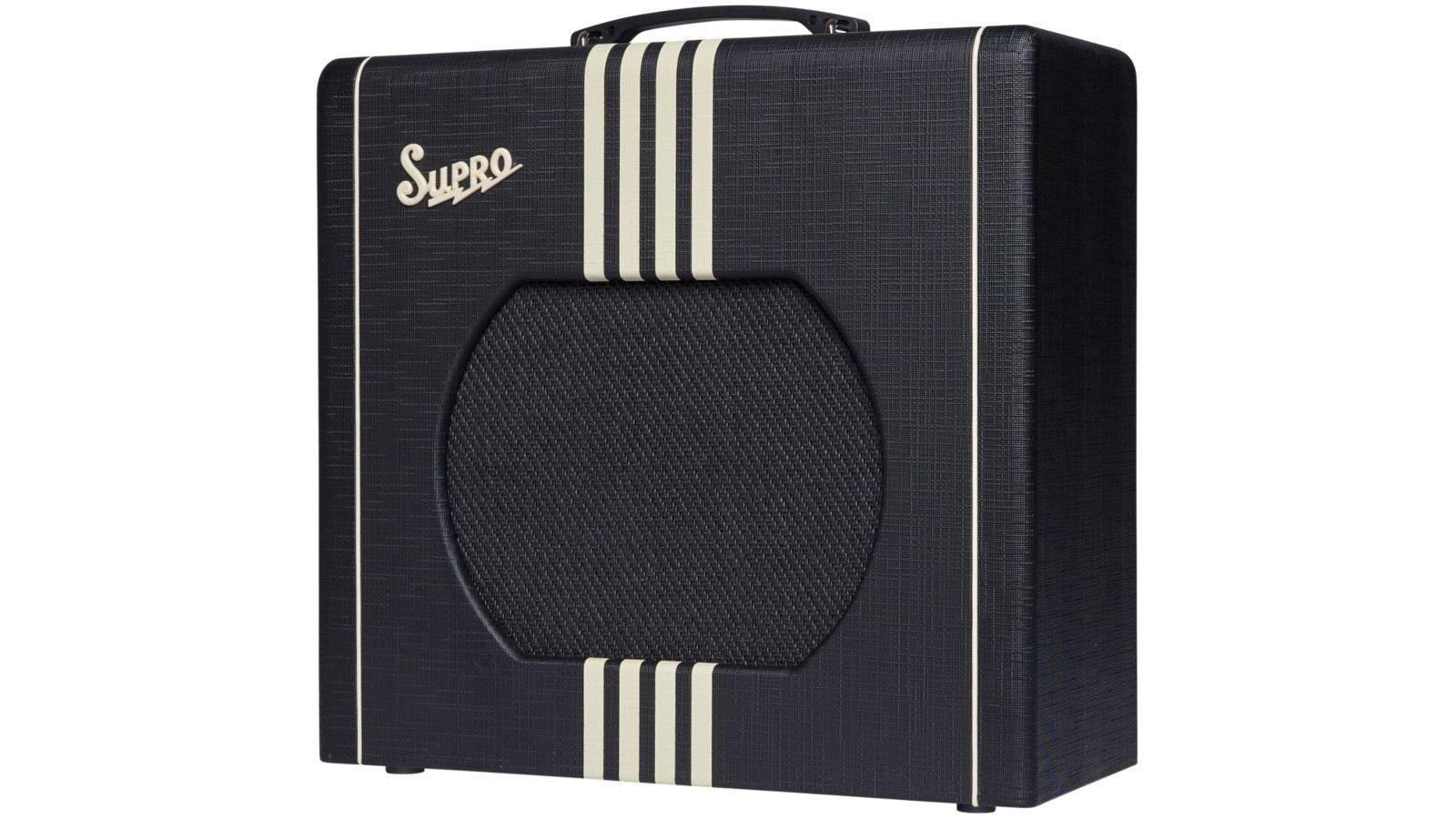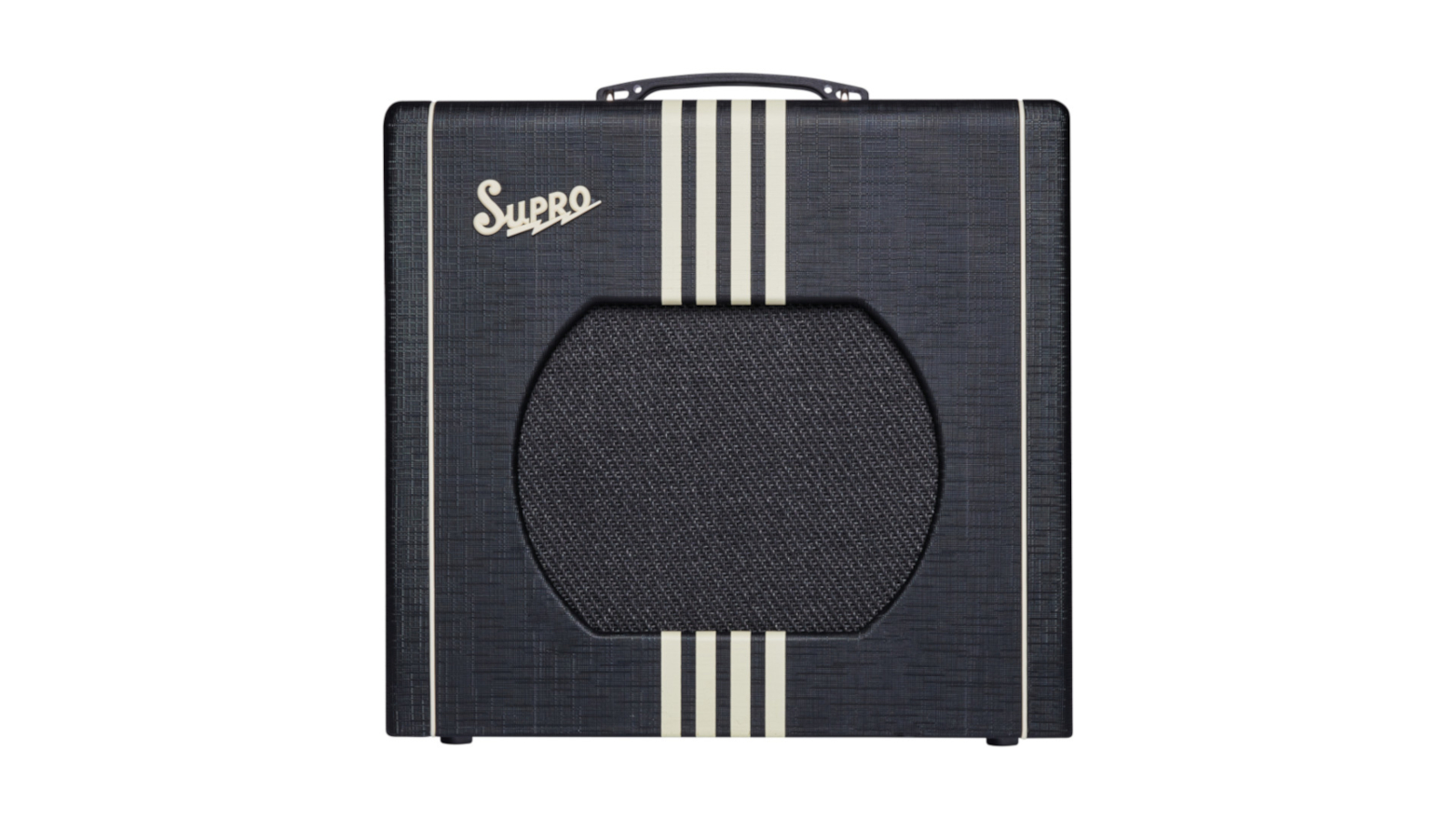GuitarPlayer Verdict
A straightforward and affordable amp that can be dialed in for a range of blues, rock and roll, and alt-rock tones. Easy to have fun with and a great introduction to tube-amp land for those making their way up the scale.
Pros
- +
Fun, stylish and compact
- +
Good versatility for its price
- +
Plenty of character
Cons
- -
Boost and drive aren’t adjustable
- -
Low end can get a little tubby with a neck humbucker
You can trust Guitar Player.
The new Delta King 12 takes its visual cues from the 1950s Valco-made Supro Comet, with its TV-front cabinet and vertical racing stripes. While the amp pays tribute to the blues roots that give it its name, Supro cleverly updates the formula with a handful of features that contemporary players will appreciate, paying homage to the original while expanding the Delta King 12’s versatility.
At its heart, the Delta King 12 is still a simple, single-ended tube amp. It has just one output tube and requires a single 12AX7 preamp tube, since no phase inverter is needed. The output tube is a 6L6GC that delivers a full 15 watts, compared to the four watts or so that the single 6V6GT produced back in the day. (The Supro Supreme and other similar Valco/Supro amps of the era used two 6V6s.)

Supro has hung a plethora of appealing features around that framework. Controls include volume, treble, mids, bass, reverb and master, with toggle switches for boost and drive. Yes, Supro has judiciously ladled on solid-state bells and whistles to make this compact combo a kind of amp-and-pedals-in-a-box affair. Considering that effects maker Pigtronix is part of Supro’s parent company, Bond Audio, the concept is intriguing.
The boost is FET (Field Effect Transistor) driven, and the drive control engages Pigtronix’s own FAT high-gain mode. Neither is adjustable, but both are foot-switchable. The solid-state reverb uses a genuine spring tank and is not foot-switchable. There are also line-out and power-amp input jacks on the back panel, alongside the TRS jack for a dual-button foot switch. No switch is included, but any standard unit will work.

In addition to its feature set, the Delta King 12’s compact dimensions and easy-carry weight should help drive its appeal. The retro combo cab measures just 17 by 16 by 7.5 inches and weighs a mere 28 pounds, including the custom 12-inch DK12 speaker. (For guitarists who need or desire something even more diminutive, Supro offers the progressively smaller Delta King 10 and Delta King 8.)
While our test model came in all-black vinyl with white piping and striping, Supro also offers a two-toned lacquered tweed with black sides. Overall, the Delta King 12 is tastily and tidily put together and evokes the image of those luggage-like boxes of old.
Internal construction on this assembled-in-China Supro comprises consumer-grade stuff on a printed circuit board, but the amp appears robust and relatively roadworthy for the price range, with substantial transformers, and it revealed no issues throughout our testing. Played with a Gibson Les Paul with PAF-style humbuckers and a Fender Stratocaster with traditional single-coil pickups, the Delta King 12 proved a fun little combo with a reasonable amount of sonic shape-shifting capability.

It has some of that toothsome single-ended give and compression in the attack, which is part of the appeal of this breed of amp, but Supro has wisely voiced it to be fairly crisp and tight on its own, up to a good halfway on the volume and master. The boost and drive kick in the dirt from there. Somewhat characteristic of such circuits, especially when packed into relatively small cabs, the bass can get a little flabby once you start pushing things (even with the bass knob dialed down low). That’s especially true on a neck humbucker, but most players will learn to work with it.

Though they are preset, the boost and drive levels are well chosen and provide handy “more” and “even more” modes when you need them. A little oddly, while the boost seemed tailor-made to goose the Strat into a thicker, juicier dimension, it also delivered a bigger volume jump at some amp settings with the single-coils than it did with the Les Paul’s humbuckers, which might be characteristic of the design. Conversely, while the drive sounded good with both electric guitars, it could lean just a little jagged and tattered sounding with the single-coils on occasion, but was still very effective. The reverb sounds entirely decent for the price range and presents an appealingly lush wash that isn’t oppressive until near the top of its range.
While it’s not as loud as some prominent 15-watt combos, the Delta King 12 pushes enough decibels to hang with the average drummer in a small club – or, of course, anywhere, once you mic it up or inject its line out into the FOH.
All in all, it has an appealing personality for a straightforward and affordable amp that can be dialed in for a range of blues, rock and roll, and alt-rock tones, even before you kick in the built-in overdrive modes. Put it all together and the package makes it a compact combo that’s easy to have fun with, or a great introduction to tube-amp land for those making their way up the scale.
Dave Hunter is a writer and consulting editor for Guitar Player magazine. His prolific output as author includes Fender 75 Years, The Guitar Amp Handbook, The British Amp Invasion, Ultimate Star Guitars, Guitar Effects Pedals, The Guitar Pickup Handbook, The Fender Telecaster and several other titles. Hunter is a former editor of The Guitar Magazine (UK), and a contributor to Vintage Guitar, Premier Guitar, The Connoisseur and other publications. A contributing essayist to the United States Library of Congress National Recording Preservation Board’s Permanent Archive, he lives in Kittery, ME, with his wife and their two children and fronts the bands A Different Engine and The Stereo Field.
A gigantic $360 off Positive Grid's celebrated BIAS amp sim software may have just put the nail in the coffin of my beloved valve combo
"Let’s take acoustic-electric amplification to its ultimate realization." How to make an acoustic amp shimmer like a vintage Fender, smolder like a Dumble or scream like a Marshall












